REPÜLŐMÚZEUM SZOLNOK
Super Aero 45
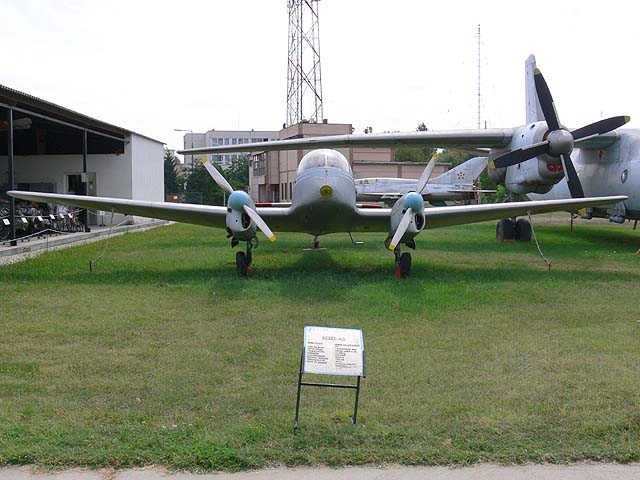 |
Ez a gép most (2008.) ötven éves. A formája most is szép, a maga korában bizonyosan roppant korszerű és formabontó volt.
A mi gépünk eredetileg az Országos Mentőszolgálat gépe volt (HA-OMC).
This plane just turned 50 (2008). Her form is nice even now, in her time she was likely very cutting edge.
Our airplane originally belonged to the National Ambulance Service (registry HA-OMC).
|
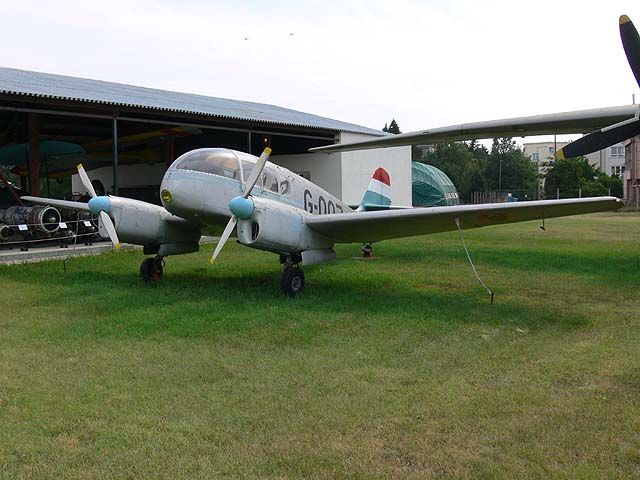 |
Két, viszonylag kis teljesítményű négyhengeres, már akkor sem túl korszerű soros motor forgatta az azonos irányban forgó légcsavarokat.
Némi rokon vonást mutat a Me-110/210 formájával.
Ha jobban megnézzük, tulajdonképpen klasszikus repülőgép forma volna, ha az orra hosszabb és hegyesebb lenne. A rövid és tompa orr viszont az egész gépre kihat a jellegzetességével.
The two four cylinder
engines were of rather low performance and weren't very |
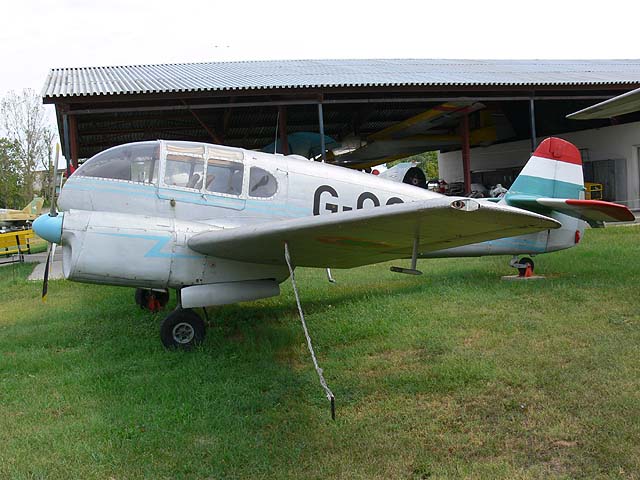 |
A légcsavarkúp előbb van, mint a gép orra.
The propeller hub fairings
reach further forward than the plane's nose. |
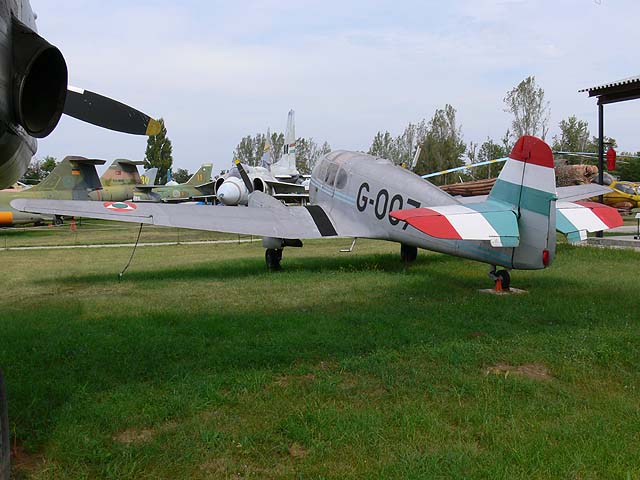 |
Talán innen nézve látszik, hogy tulajdonképpen klasszikus formája van a gép legnagyobb részének. Egészen becsapós!
From this angle, it really does look like an airplane, for the most part. Pretty tricky! |
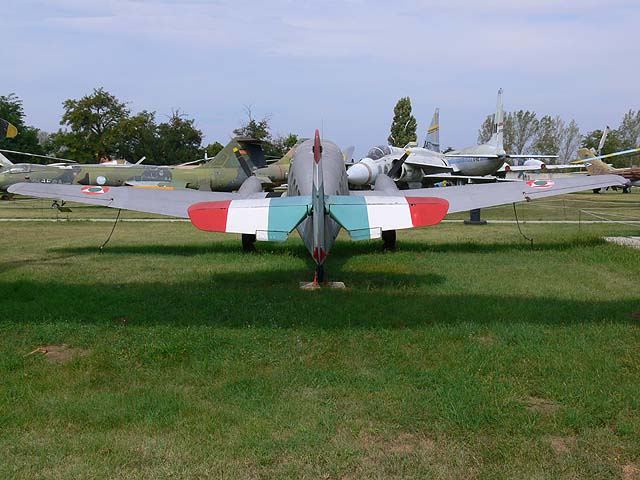 |
A hátulnézet is szép klasszikus formát mutat.
The rear view exhibits classic lines, too. |
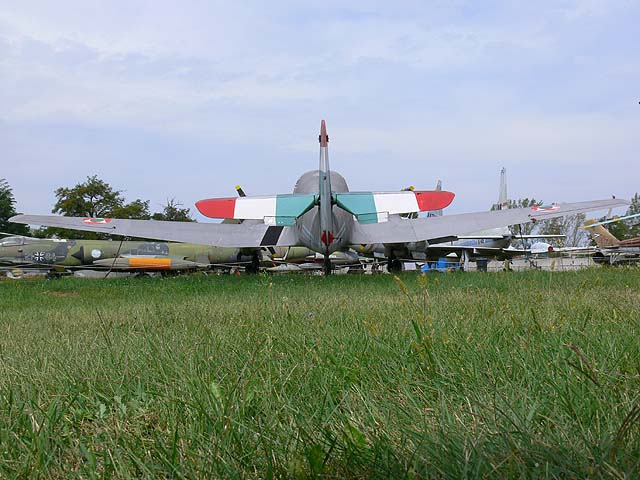 |
Megnézzük fűnívóból is.
And here, from grass level. |
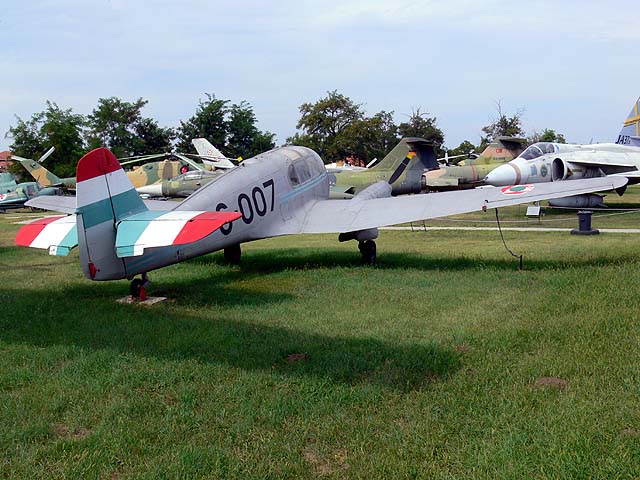 |
|
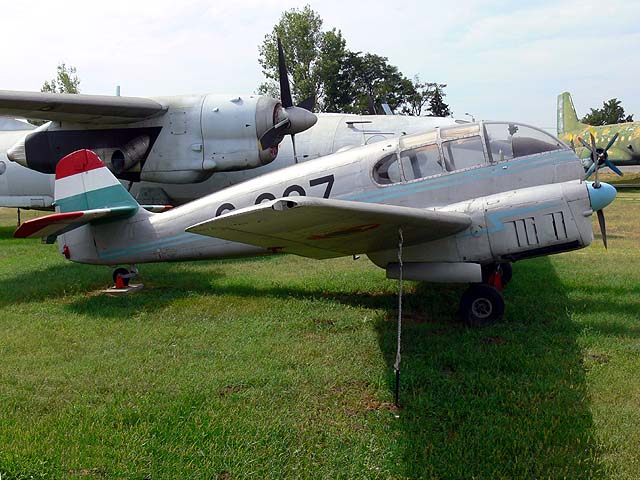 |
|
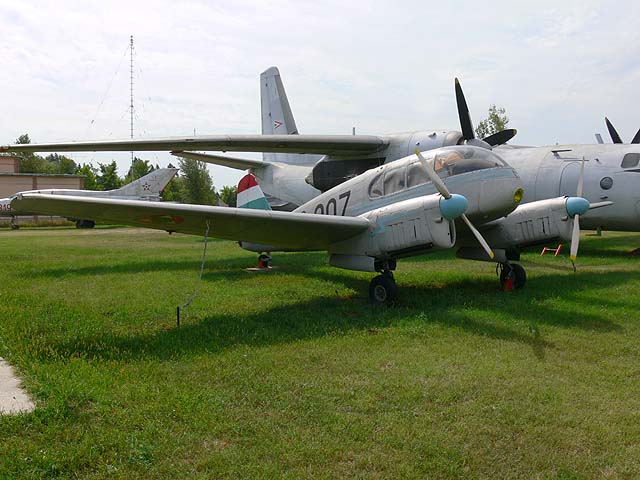 |
Innen kimondottan formabontó!
But from here, she's very
unusual! |
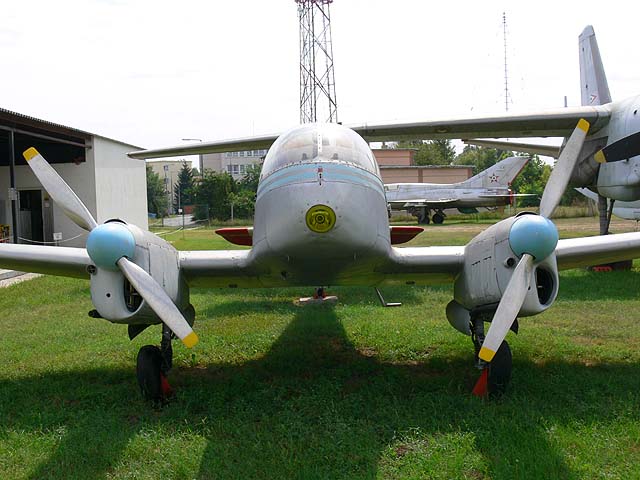 |
Ha egy palotapincsit vagy egy mopszot nézel, ugyanaz az érzésed támad mint most: az orráról valami hiányzik !
You get the same feeling
looking at a Pekinese or a pug as you do now: something's
|
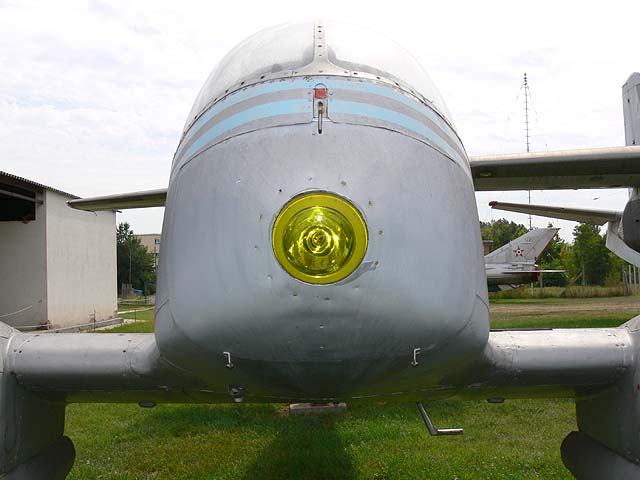 |
A reflektor valamelyest oldja a tompa orr ürességét.
The headlight sorta breaks
the emptiness of the blunt nose. |
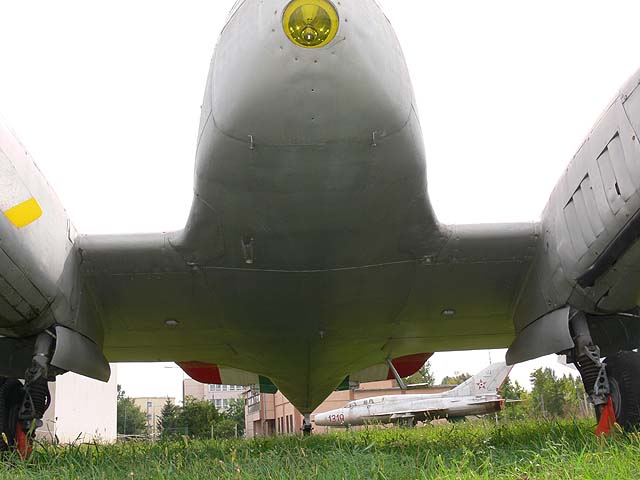 |
A hasán szinte semmi látnivaló.
There's practically nothing to see on the belly. |
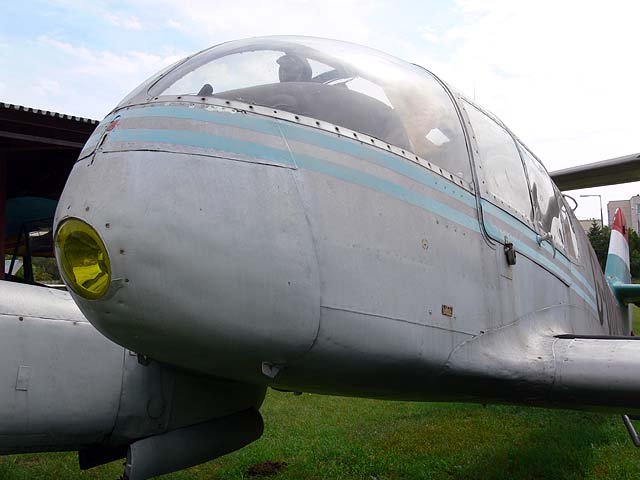 |
Manapság is ritka az ilyen orrkialakítás.
Even nowadays, such a nose arrangement is a rarity. |
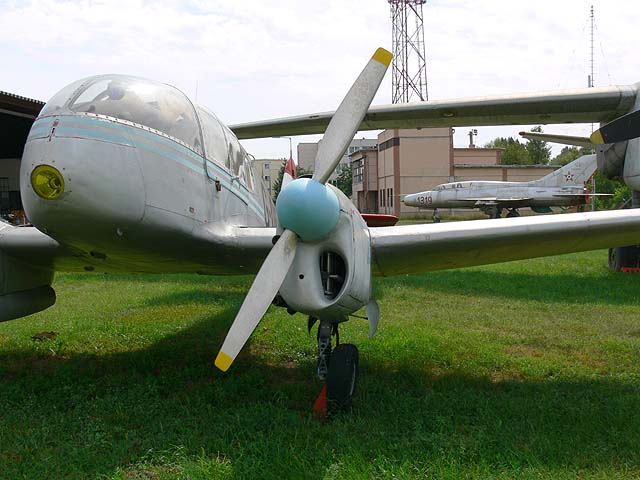 |
A jobb oldali sovány kis motorocska. Walter Minor III típusú, négyhengeres, mindössze 105 LE teljesítményű.
The skinny little engine on the left. It's a Walter Minor III 4-cylinder, with altogether 105 HP. |
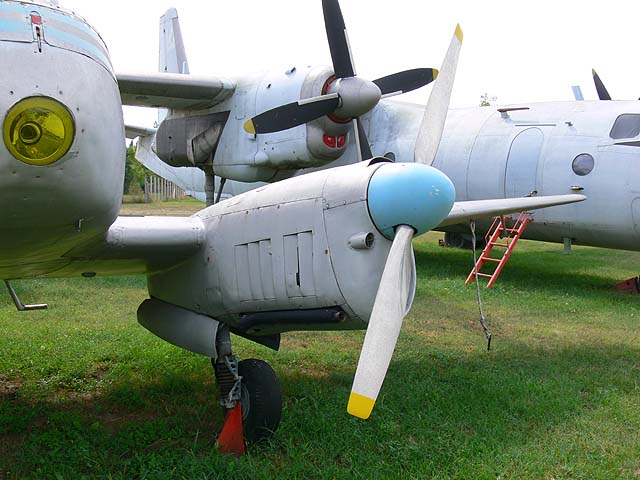 |
A főfutókat a motorgondolákba lehet behúzni.
The main gear retracts into
the engine nacelles. |
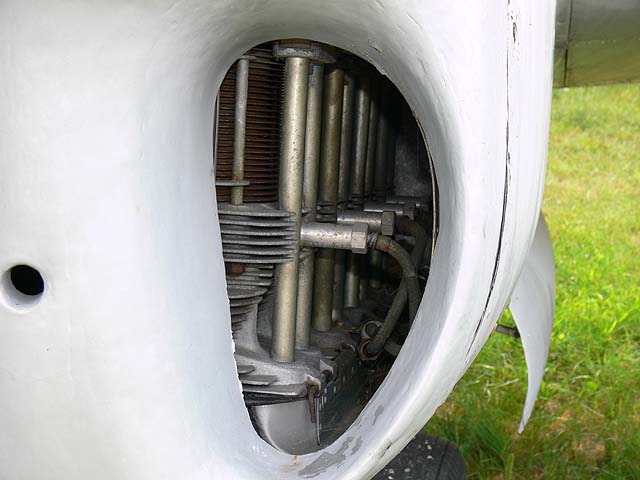 |
A hűtőlevegő beömlőnyílása, mögötte a hengerek, a szelepmozgató rudak és gyújtókábelek ismerhetők fel.
Behind the air intake we can identify the cylinders, the rockers and the sparkplug cables. |
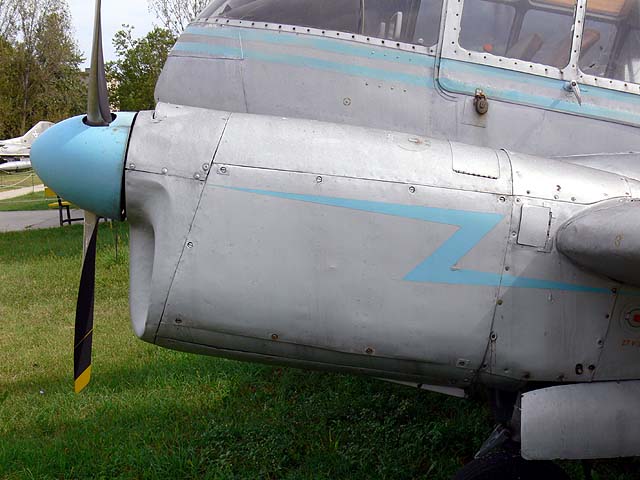 |
A teljes motor a szárny belépő éle elé van építve.
The entire engine is
mounted in front of the wing's leading edge. |
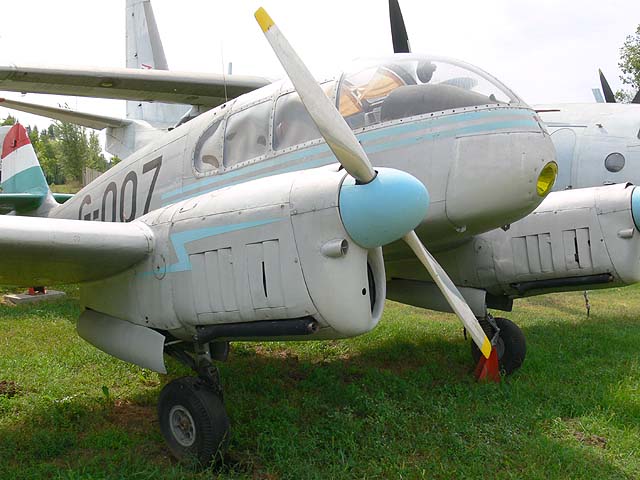 |
A jobb motor nem tartogat meglepetést: pontosan olyan mint a bal.
The engine on the right doesn't hold any surprises, either: it's identical to the one on the left. |
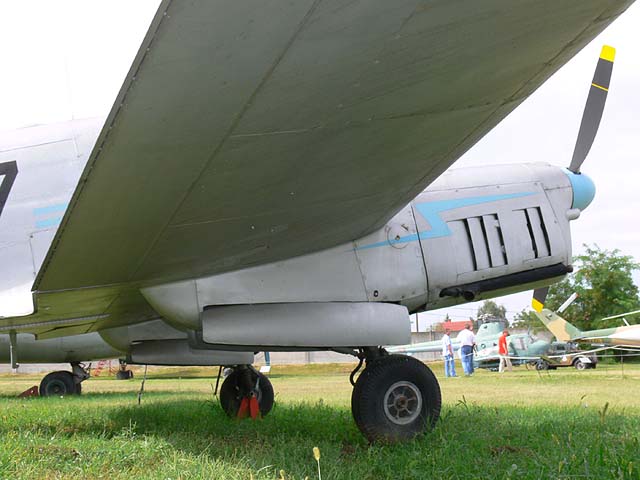 |
A jobb oldali motor/főfutó gondola.
The starboard nacelle. |
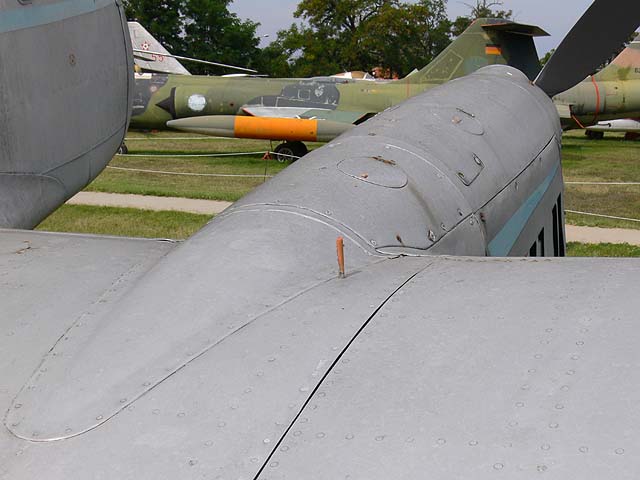 |
A főfutó kinti helyzetét jelző mechanikusan mozgatott pecek, azaz "katona".
The moving mechanical indicator showing the extended state of the main gear, that is, the "soldier." |
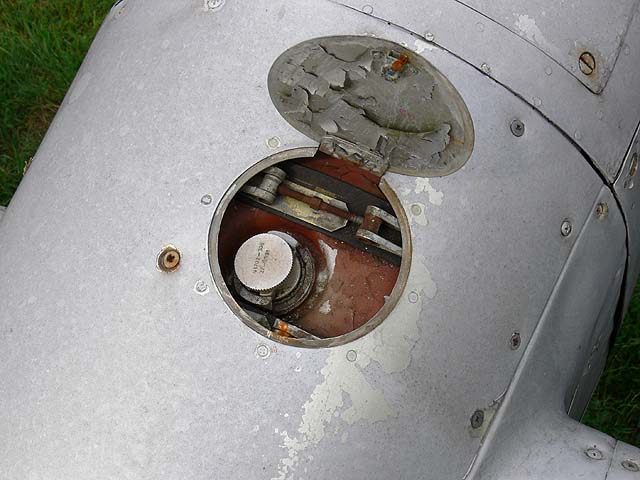 |
Az olajtartály feltöltő nyílása a szárny belépő élének vonalában van.
The oil filler is in line
with the wing's leading edge. |
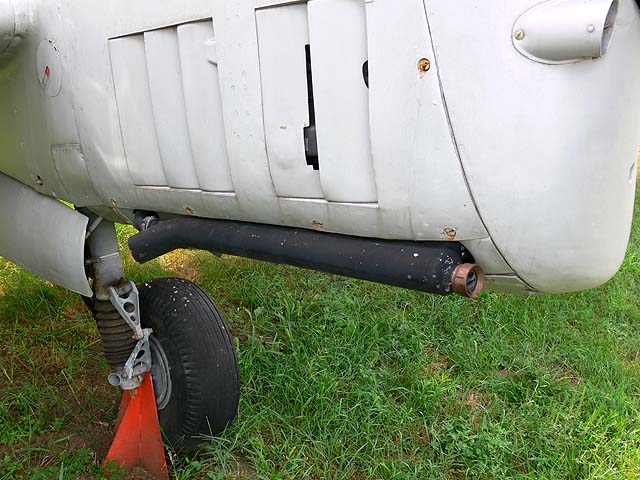 |
A kipufogócsövön hőcserélő van, amit a kabin fűtésére, esetleg a belépőélek jégtelenítésére használtak.
There's a heat exchange on the exhaust pipe, maybe used for deicing or for heating the cabin. |
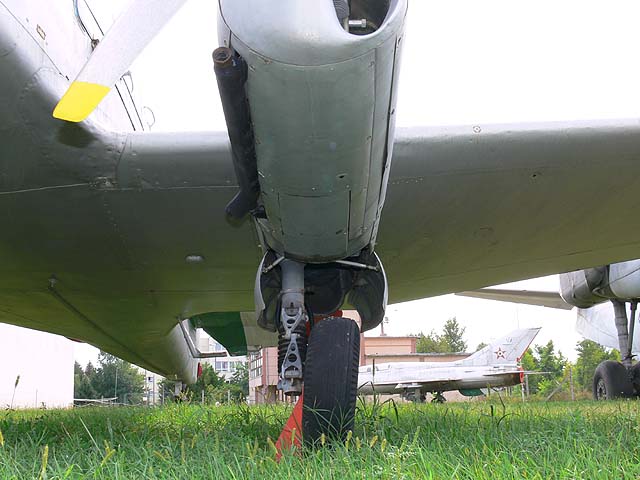 |
A főfutó határozottan befelé "csámpít".
The main gear is definitely cambered inwards. |
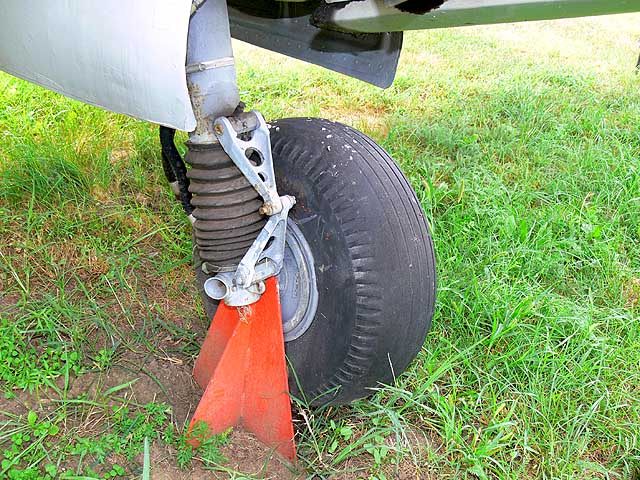 |
A rugóstag/lengéscsillapító.
The shock absorber. |
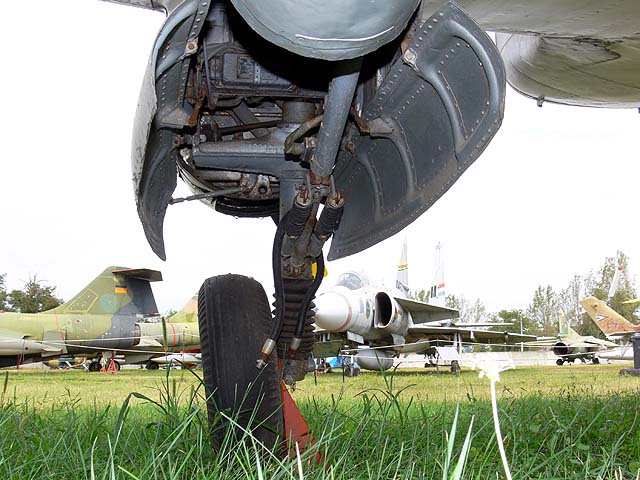 |
A bal...
The left... |
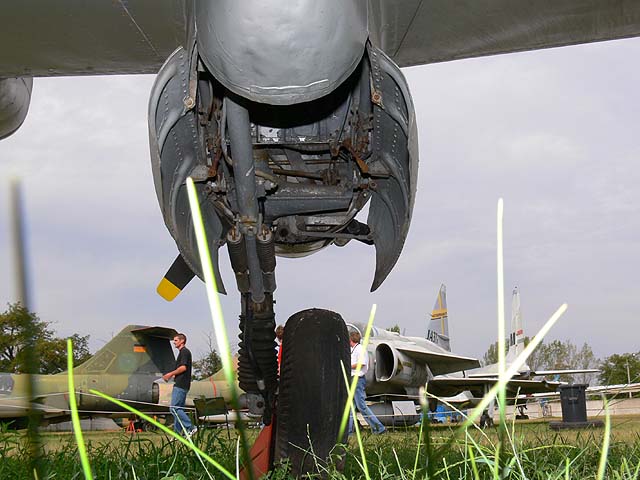 |
...és a jobb főfutó aknája.
...and the right wheel well. |
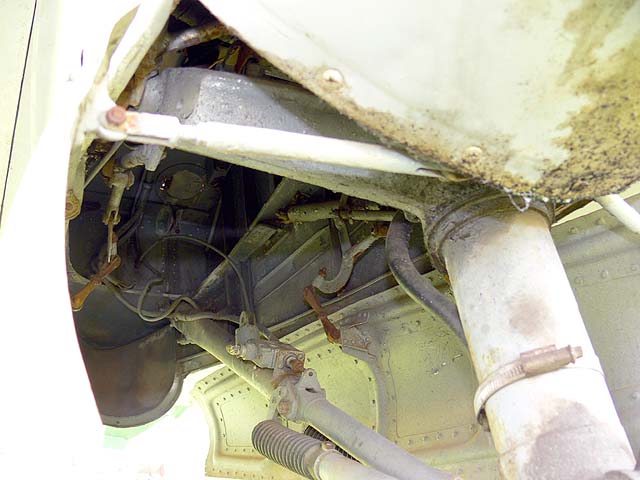 |
Na találd ki, ez melyik főfutó! Elárulom: a jobb.
Guess which main gear this is! I'll tell you: the right one. |
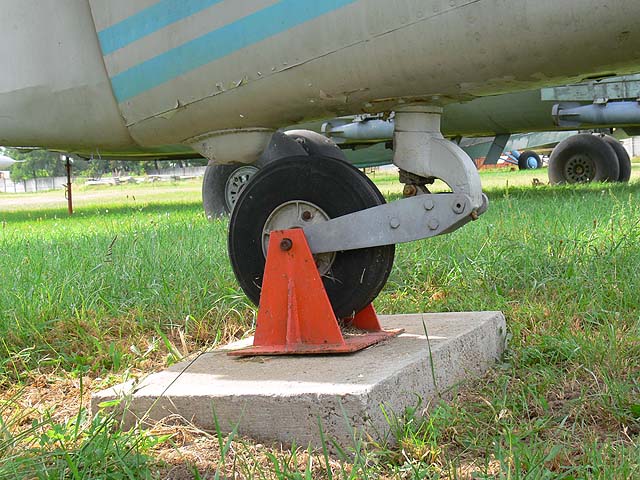 |
Az önbeálló farokkerék.
The self-adjusting tail wheel. |
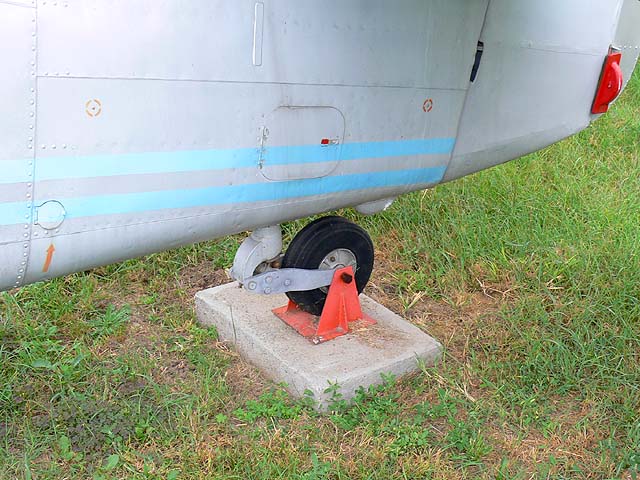 |
|
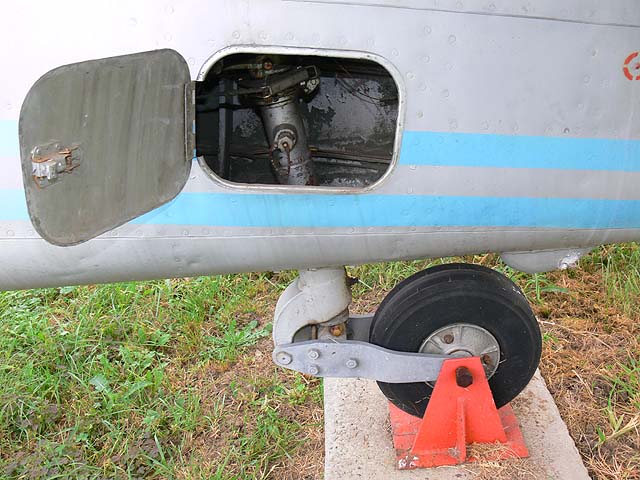 |
A farokkerék lengéscsillapítóját itt lehet feltölteni. Vagy az önbeálló tengelyt kenni?
The tail wheel's shock absorber can be filled here. Or is this for greasing the self-adjusting shaft? |
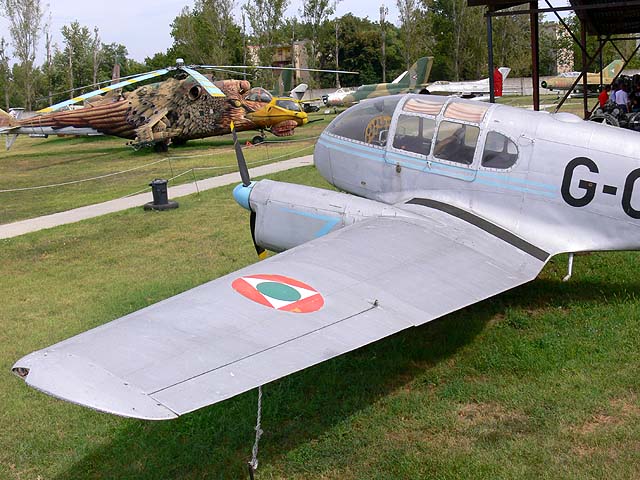 |
A bal szárny az An-26 létrájáról nézve. Sok különlegesség nincs rajta.
The left wing, viewed from the An-26's stairs. Not much special to see on it. |
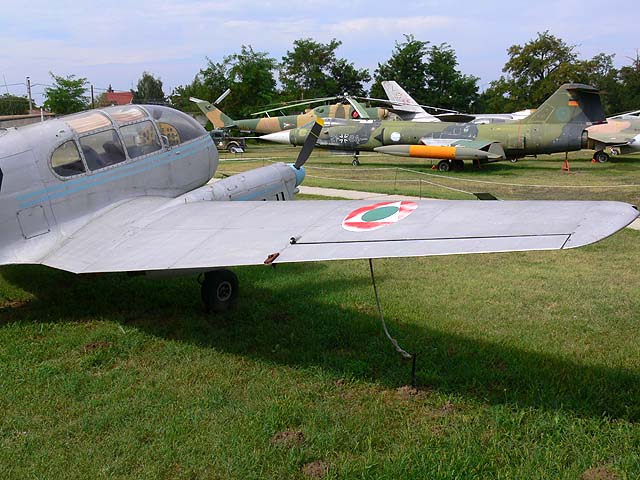 |
Azaz mégiscsak van: nincs rajta fékszárny!
Or maybe there is: no flaps! |
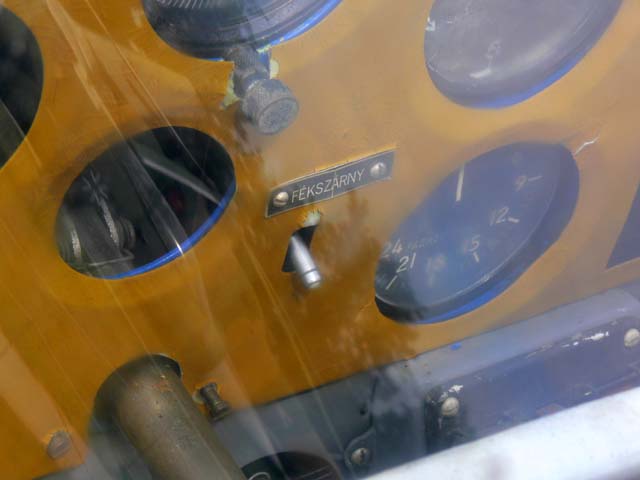 |
Egy pillantás a műszerfalra: mégiscsak van fékszárny! De hol?
A glance at the instrument panel: there are flaps! But where? |
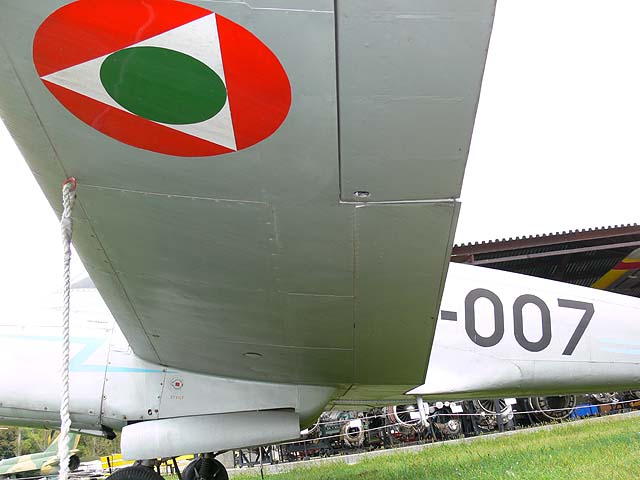 |
A bal szárny alatt vagyunk. Fölül a csűrőlap, alatta egy kicsit keskenyebb panel látszik. Nos, ő a fékszárny. Azért nem látszik, mert a szárny felső burkolata teljesen eltakarja, csak akkor látszik, ha nyitva van. Valószínűleg gond lehetett a zárt helyzeti rögzítésével, mert felújításkor egy csavarral megfogatták. A csavar az oldalszám kötőjele előtt látszik.
We're under the left wing.
To the top of the image is the aileron, beneath it a |
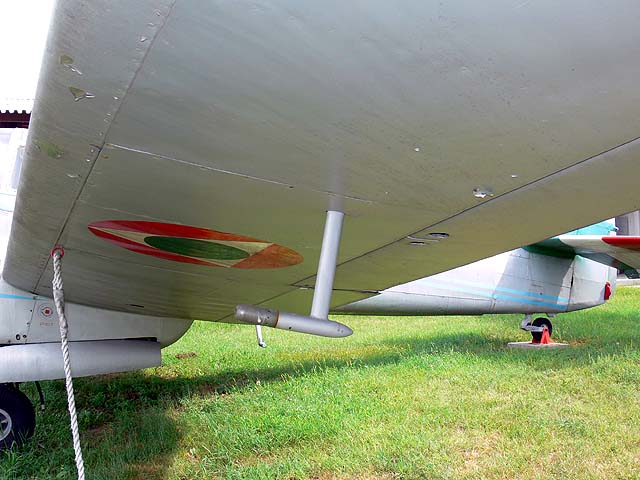 |
A Pitot-csövet a bal szárnyon helyezték el. Olvastam, hogy ez a fajta elhelyezés veszélyeket rejt: éles fordulóban, a forduló irányától függően többet vagy kevesebbet mutat a gép (a törzs) tényleges sebességénél. Esetünkben jobb forduló közben a sebességmérő még a minimális sebességnél többet mutat, amikor a jobb szárny már átesik. A harmincas években emiatt történt egy magyar utasgéppel katasztrófa.
The pitot tube is on the
left wing. I've read that this sort of arrangment can be
An airliner in Hungary
succumbed to this in the 1930s. |
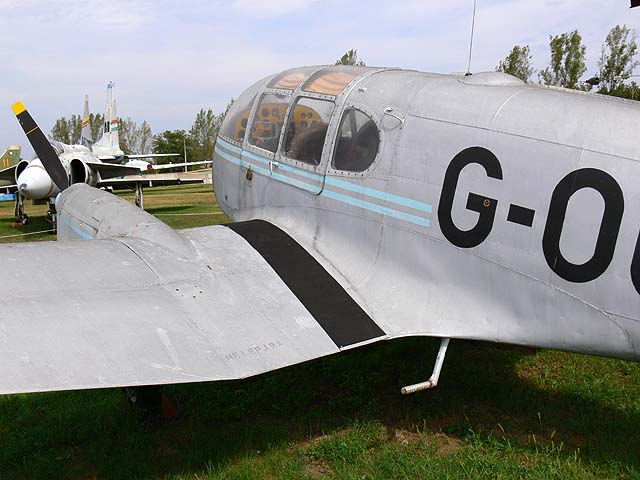 |
A légellenállás szempontjából fontos a szárny és törzs közötti átmenet. Ezen a gépen példásan meg van oldva.
The junction between the wings and the fuselage is important from an aerodynamic standpoint. On this place, the solution is exemplary. |
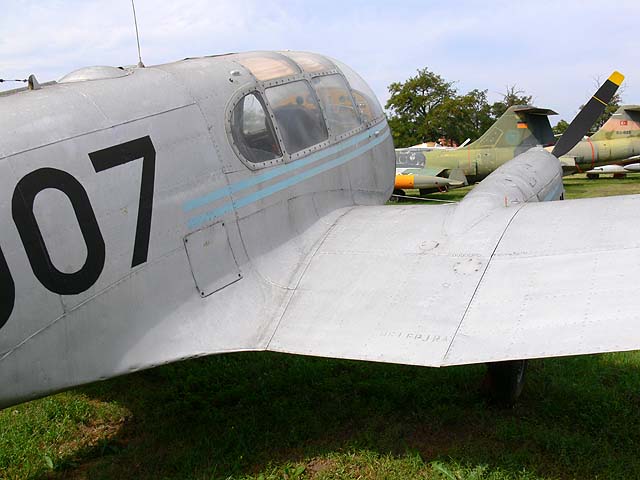 |
Itt talán még jobban látszik. Nem kevés rokonságot mutat a DC-3-mal - és az utána következő generáció számos, kicsi és nagy tagjával.
It's even more visible
from this angle. It exhibits not a little relationship to
the DC-3 - and many small and large members of the
subsequent generation. |
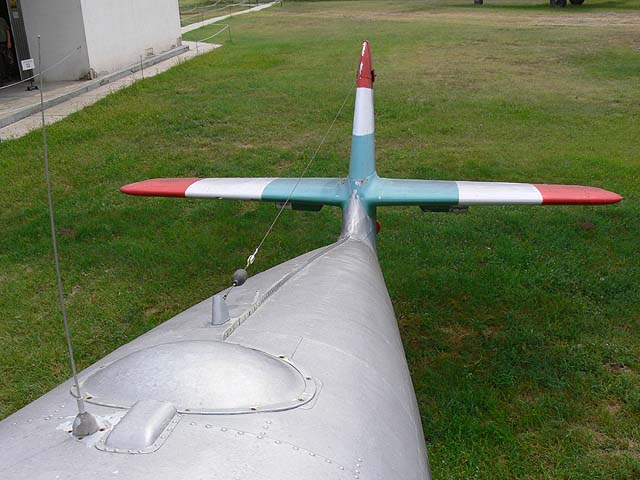 |
A farok teljesen klasszikus kialakítású.
The empennage is a totally classic design. |
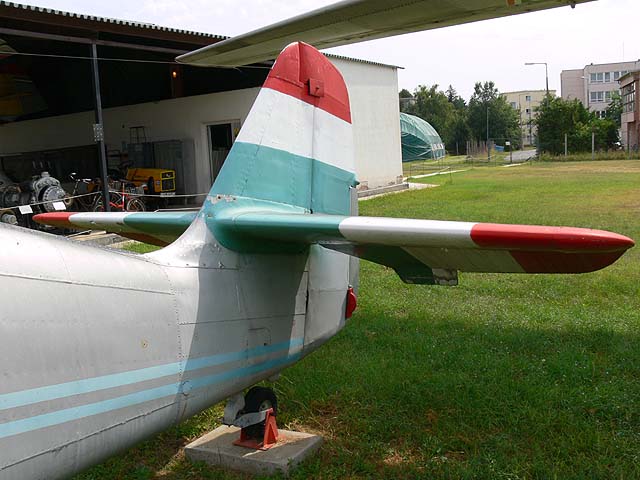 |
|
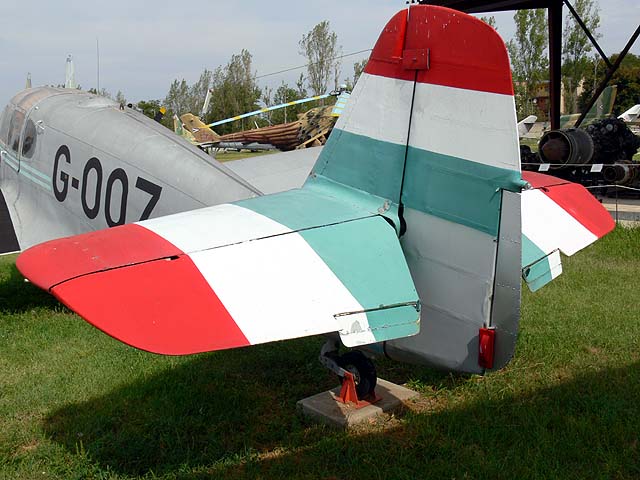 |
Mindkét magassági kormányon és a függőleges kormányfelületen is van trimmlap. Ilyen kis gépen nincs mindig mindkét magassági kormányra felszerelve. Viszont nem találunk csűrő-trimmet. Lehet hogy a magassági trimmlapok aszimmetrikus kitérítésével oldották meg a feladatot ? Ennek ellentmondani látszik, hogy ezek a lapok nagyon közel vannak a törzs hossztengelyéhez, így a nyomatékuk arra minimális.
Both elevators and the
rudder have trim tabs. Such a small craft doesn't always This seems to be contradicted by the fact that the tabs are very close to the horizontal centreline of the fuselage, so their effect on that would be minimal. |
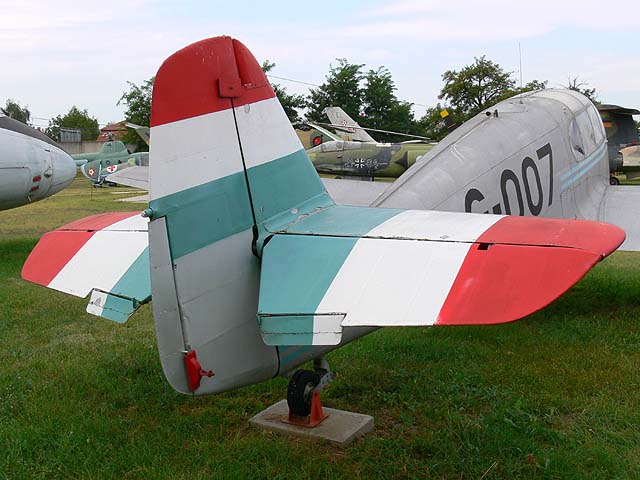 |
|
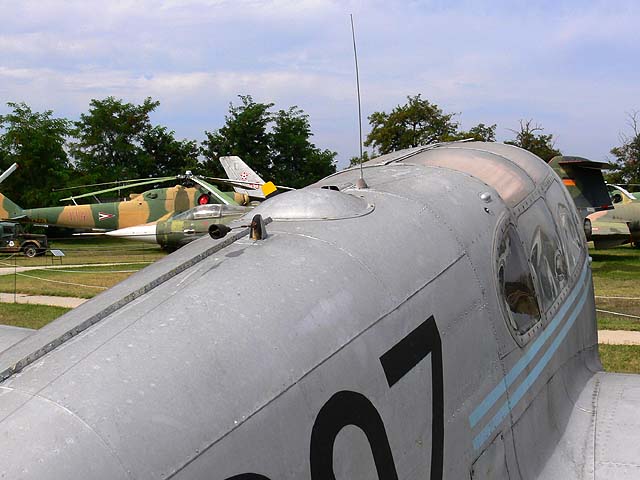 |
A tetőn egy hosszabb (RH?) huzalantenna és egy rövidebb (URH) botantenna, közöttük egy gömb alakú dudor. A dudor - bár ezüstre van festve - műanyagból készült, és a rádióiránytű antennáját rejti.
On top is a longer wire
antenna (HF?) and a shorter (UHF) whip antenna, between them
is a hemispherical lump. Though painted silver, the lump is
made of plastic and conceals the |
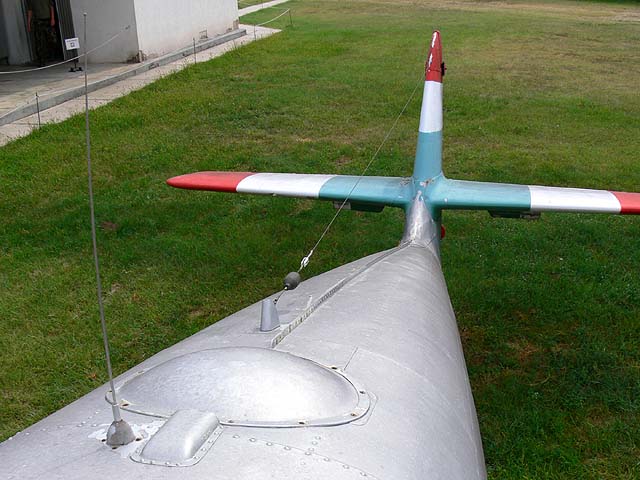 |
A törzs tetején a két fél borítólemezt taréj formán szegecselték össze.
The left and right fuselage
sheathing sheets were riveted together on the top of the
plane in such a manner as to form a crest. |
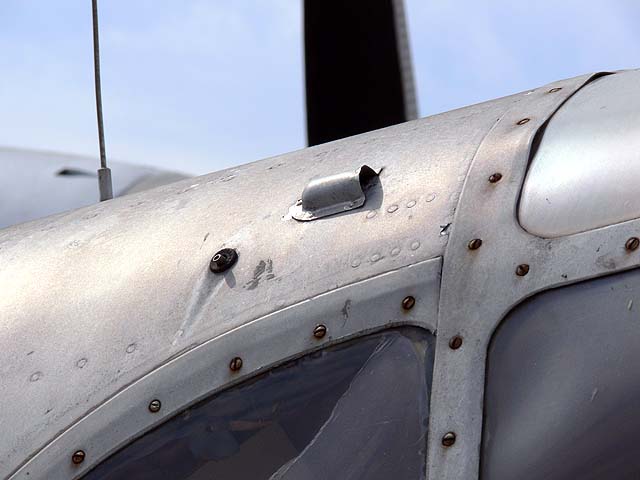 |
A kabin szellőzését szolgáló levegő-bemenet és kondenzvíz-kivezetés a hátsó ülések fölött.
The air intake for cabin ventilation and a condensation outflow are located above the rear seats. |
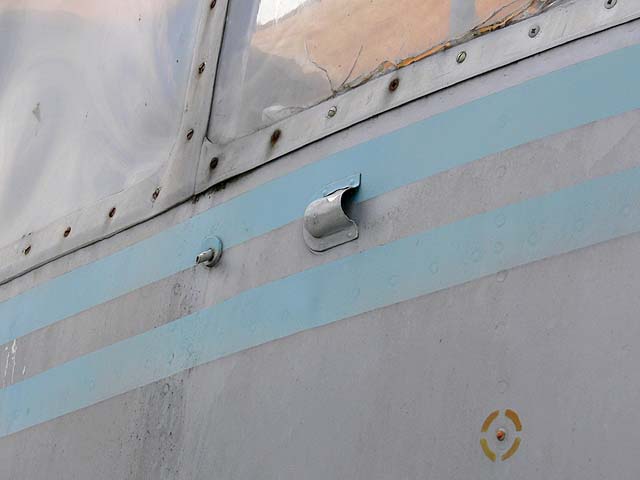 |
Ugyanilyen van a jobb első ülés mellett is.
Lejjebb egy szintezési pont.
There's more of these beside
the right front seat. Further down, a balancing point. |
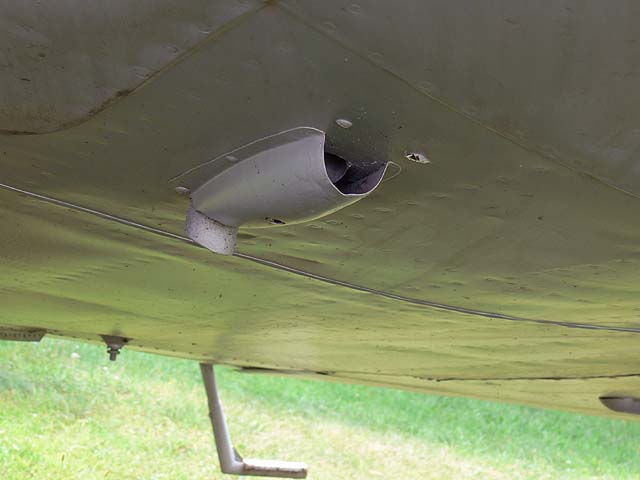 |
Valahol a hátsó ülések alatt is van levegő-bevezetés.
Somewhere under the rear seats is another air intake. |
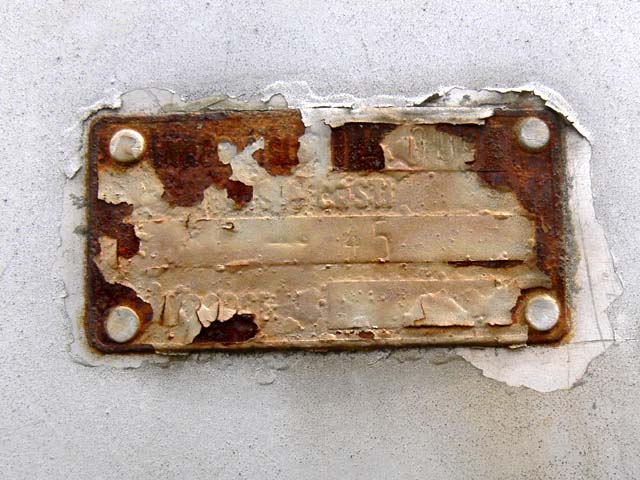 |
A gép adattáblája. Némi munkával még olvashatóvá lehet tenni. A gyári szám: 04-009
The dataplate. With some work, it could be made legible. The plane's factory serial number is 04-009. |
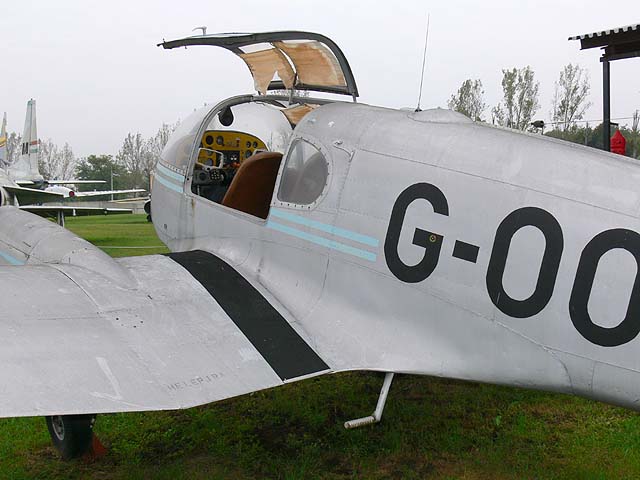 |
A fülkeajtó hívogatóan nyitva!
A látszat ellenére nagyon kényelmes a beszállás, a kapaszkodót jobb kézzel megfogod, a lábtartóra jobb lábbal fellépsz, a bal lábadon nem kell nagyot emelni és máris a szárnyon vagy.
The open cabin door beckons! |
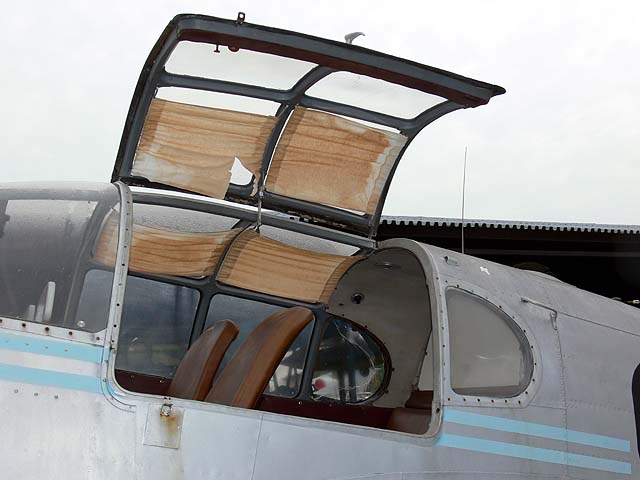 |
Az ajtó felfelé nyílik, nagy a szabd nyílás. A beszállás kényelmes, kivéve talán a jobb első ülést, a másik oldalon ugyanis nincs ajtó...
The door opens upwards, the opening is quite large. Climbing in is quite comfortable, except perhaps for the right front seat, as there's no door on that side... |
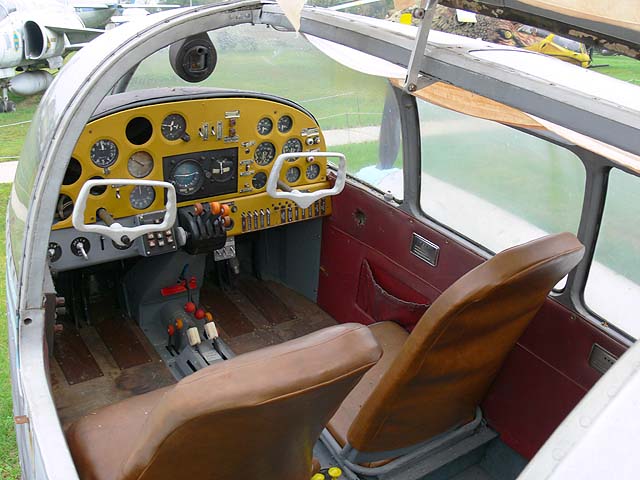 |
A pilóta és a másodpilóta ülése a műszerfallal.
The pilot's and copilot's
seats, along with the instrument panel. |
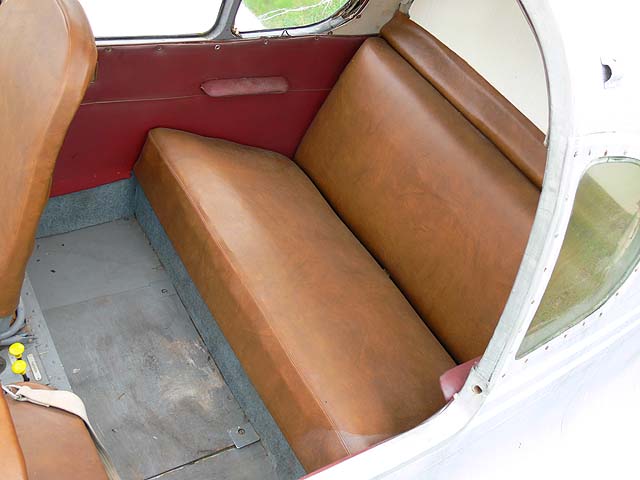 |
A hátsó ülés szakasztott a korabeli Pobjeda autóé. Ráadásul semmi biztonsági öv! (Bár az is lehet, hogy ennek pótlása csak a nyolc évvel ezelőtti restaurálás során maradt el.)
The rear seat bench is the
spitting image of the rear bench in the Pobeda automobile.
|
 |
A műszerfal az akkoriban alighanem futurisztikus kormányokkal.
The instrument panel. The control wheels might've been almost futuristic back in their day. |
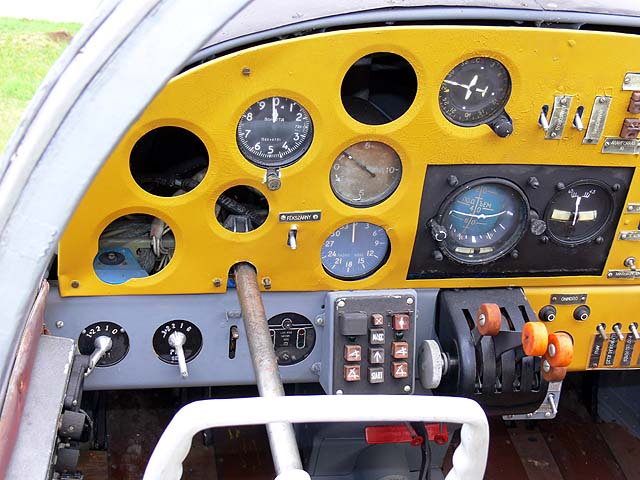 |
A pilóta műszerfala. Hát igen, nem baj ha ezt is látjátok! Nagy Andris már a restaurálás során is bedolgozott a Múzeumnak. Mesélte, hogy a műszerfal összes rezgéscsillapított felfogató elemét mániákusan a helyére tette ("ezzel a tíz hüvelykujjammal !"), holott sehol nem látszik és nincs is mindre szükség a földön álló gépen.
The pilot's instrumentation.
Well yes, no harm in you all seeing this, too! |
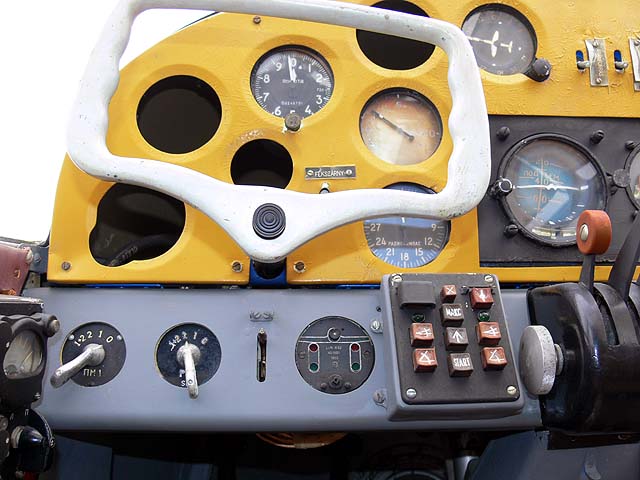 |
Meglehetősen rosszul esett neki, amikor egy-két évvel később a műszerfalat a helyéről kitépve találta, négy műszer helyén pedig csak a sötét lyuk tátongott...
Sajnos vannak roppant "kelendő" műszerek, a listavezető az időóra, a legtöbb gépből már a Múzeumba kerülés előtt kimenekítik. Sok gépből hiányzik a variométer, valamint a kis sebességtartományú (sportrepülés!) sebességmérő is. Amióta a mostani vezetés igazgatja a Múzeumot, szerencsére a "fogyás" szinte teljesen alábbhagyott...
Itt a magasságmérő, a varió és a rádióiránytű kijelzője maradt meg.
It was a very unpleasant
discovery for him when, a few years later, he found the |
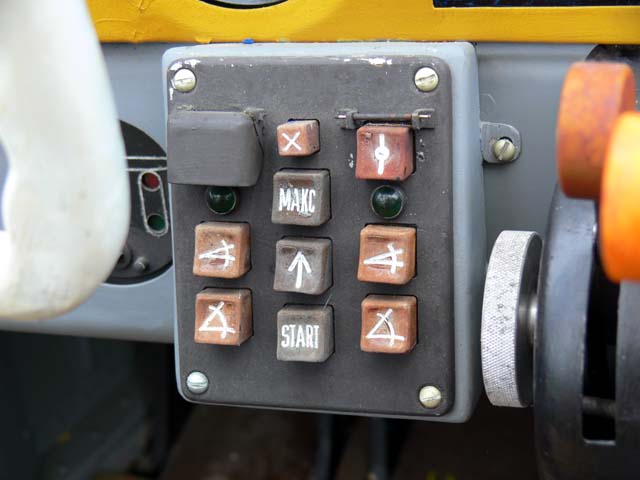 |
Egy elsőre nehezen megfejthető kezelőpanel. A tippem: légcsavar-szög állító berendezés. A tippelésben továbbmenve: két oldalt a két légcsavarra vonatkozóan vitorla állás, vitorla visszajelzés, kis állásszög, nagy állásszög. Középen valamilyen automatikus folyamat beállítása.
Hard to guess at first what
this panel is for. My guess: it's for adjusting the
feathering of the airscrews. Going further with my guess:
buttons for wide angle and |
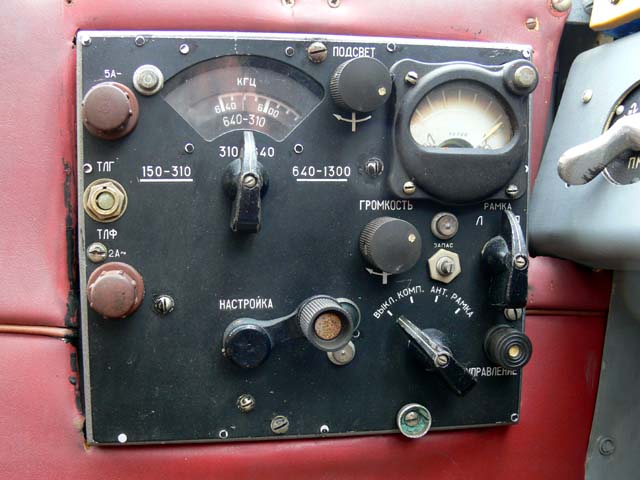 |
A rádió kezelőpanelje a pilóta bal kezénél, bár rajta kapcsolgatni feltehetően csak jobb kézzel lehetett.
The radio's control panel is at the left hand of the pilot, but it seems likely that you could only operate the knobs with the right hand. |
 |
Bizonyára utólag beépített kapcsoló, nyomógomb és narancssárga visszajelző lámpa a szélvédő pereménél. Szerintem ez a hely eléggé ki van téve a plexiről lefolyó víz okozta veszélyeknek.
This switch, pushbutton and orange light were probably installed at some later date onto the rim of the windshield. I think this area is fairly prone to damage from water rolling off the plexi. |
 |
A pilóta pedáljai. Az alsó pedál-pár az oldalkormány, a felsők a főfutók fékjei.
The pilot's pedals. The bottom pair is for the rudder, the upper pair is for the brakes on the main gear. |
 |
A folyadékos iránytű fölül, középen elhelyezve.
The liquid compass is positioned above, in the middle. |
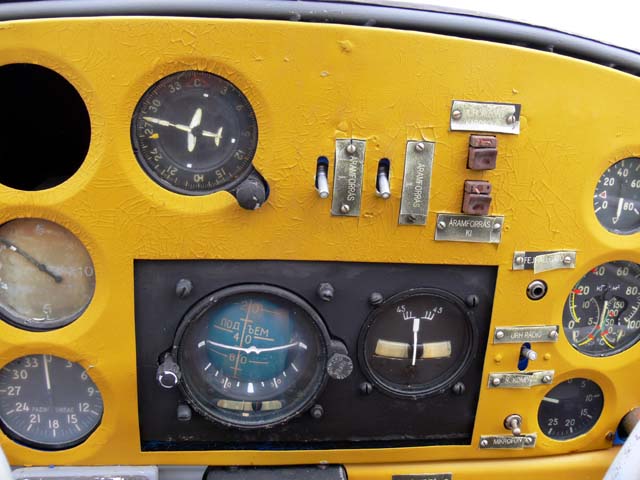 |
A műszerfal középső része: a pörgettyűs iránytű kijelzője, a műhorizont és a csúszásjelző.
The central part of the
instrument panel: the gyrocompass display, the artificial
horizon and the turn-and-slip indicator. |
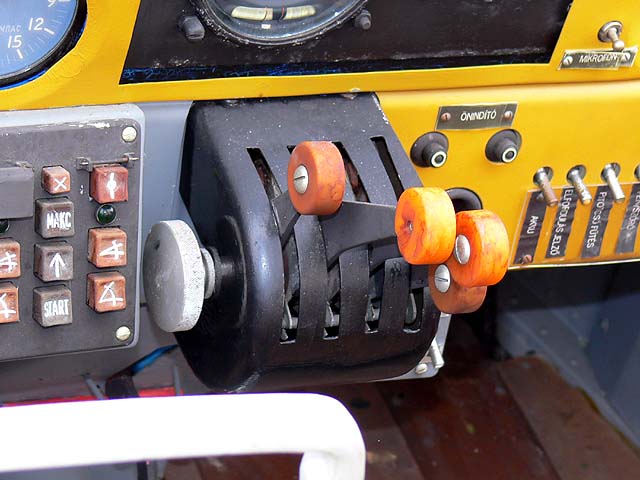 |
Középen a kis csutka gázkarok, illetve a légcsavar-állásszög szabályozó karok. A recés tárcsa szerepe ismeretlen.
In the middle, the stubby throttle handles and the levers to control the feathering of the airscrews. The function of the ridged disc is unknown to me. |
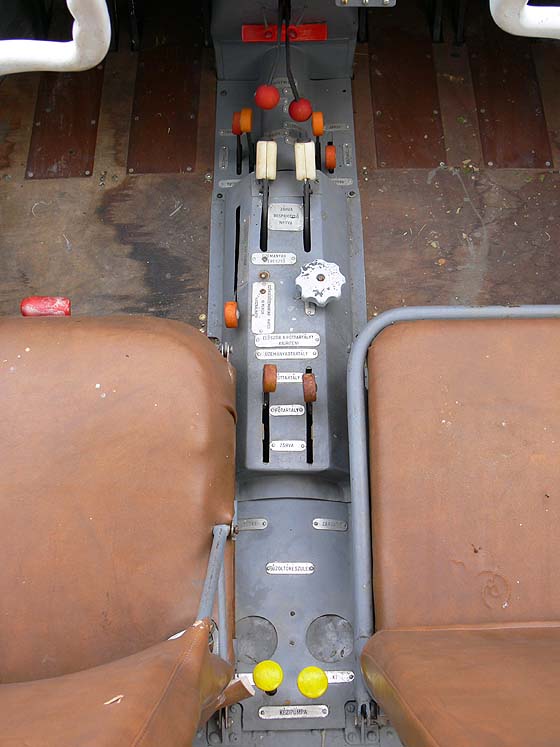 |
A középső konzol a pilóták hátának vonaláig folytatódik.
The central console reaches
as far back as the pilots' backs. |
 |
A kabinfűtés, a porlasztófűtés, a motorhűtés és a "bespriccelő" (keverékszabályozó?) szabályozókarjai.
The controls for the cabin
heaters, the carb heater, the engine cooling system and the
"sprayer" (choke?). |
 |
Mindent el tudsz olvasni, kivéve az alumínium színű tekertyű tábláját. Ez a csűrőtrimm. A csűrőlapokon nincs külön trimmlap, valószínűleg azok szimmetriáján lehet itt állítani.
The aluminum-coloured knob
is the aileron trim. Since there are no trim tabs on the
ailerons, this probably adjusts the symmetry of the ailerons.
The other signs, from "Sprayer Closed / Open," "fuel bypass (transfer valve?)", the sideways-mounted panel reads "Emergency fuel switch, can be used for ten minutes."
The upper one of the two
crosswise panels in the middle reads "Empty the backup tank
first!", Of the three towards the bottom of the photo, I don't know what the top one is (but I guess, perhaps, "backup tank."
The middle one says "main |
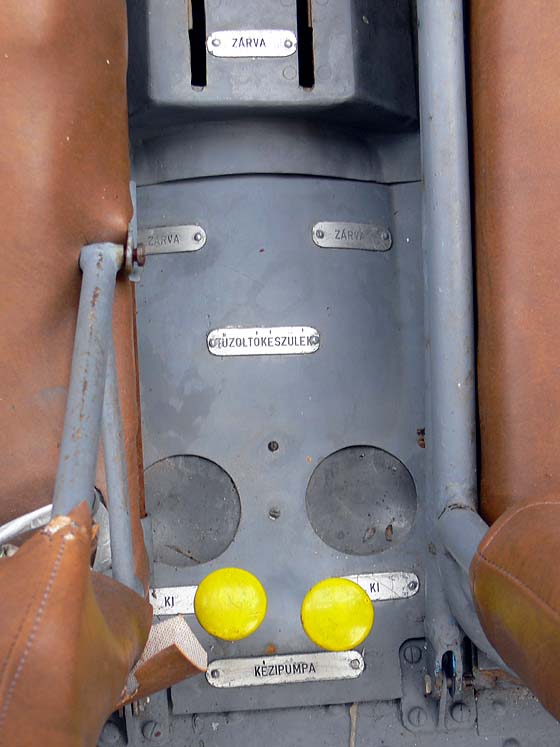 |
Tűzoltókészülék kiszerelve, mögöttük az üzemanyag kézi szivattyúja.
The fire suppression system has been removed, but at the bottom are the manual fuel pumps. |
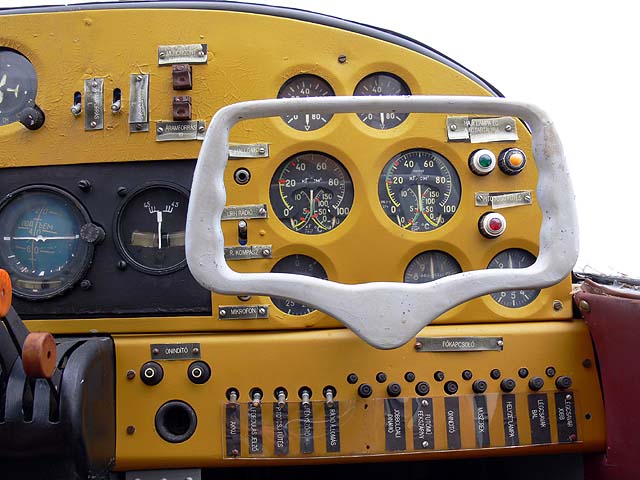 |
A másodpilóta műszerfala.
The copilot's instrument panel. |
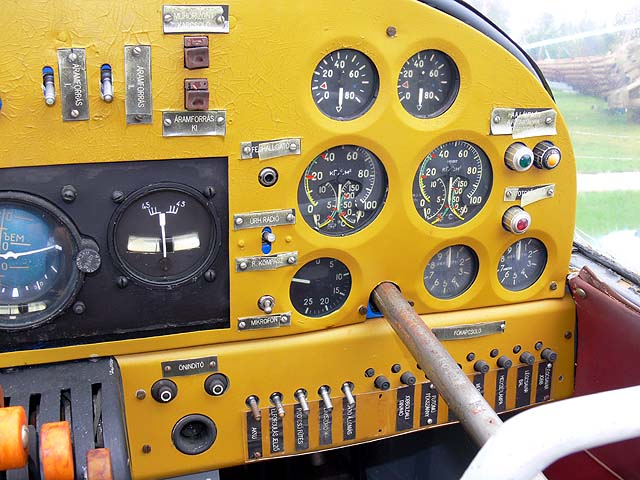 |
A kormányt kihúztuk, azaz a gépet erős emelkedésbe vittük, hogy a műszerfalat jól lássuk. Ezen az oldalon a motorokkal kapcsolatos műszerek vannak.
Fölül két egyforma műszer, amelynek mibenlétét nem ismerem. Lejjebb két egyfoma kombinált motorellenőrző műszer, mindegyik két nyomás- és egy hőmérséklet értéket mér. Lent balra megint egy sötét ló, jobbra a két fordulatszám-mérő. Alul az önindítók nyomógombjai, az elektromos fogyasztók kapcsolói és biztosítói.
Here the stick has been
pulled out, so as to get a better look at the panel. The |
 |
A szélvédő peremén egy narancssárga jelzőlámpa, feltehetően a túloldalival megegyező céllal.
This orange light here
probably does the same thing as the one on the other side. |
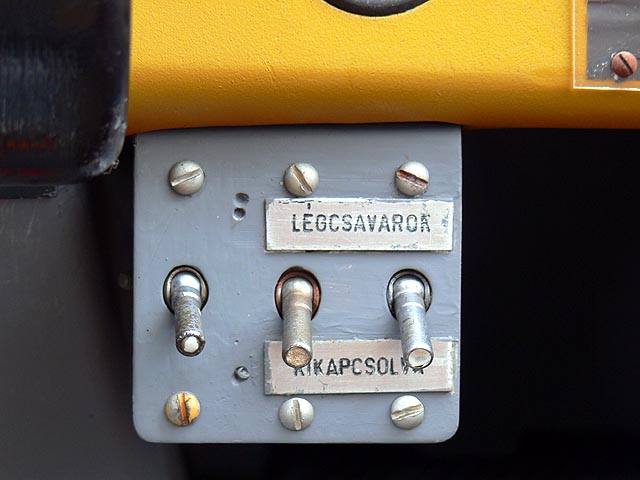 |
Egy "szakáll" a műszerfalon: csak tippem van, ez a légcsavar-jégtelenítés.
A little "goatee" on the instrument panel. This is only a guess, but maybe it's the propeller deicer. |
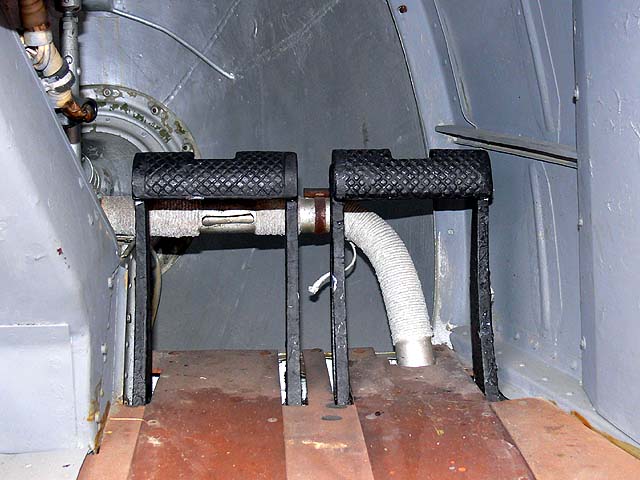 |
A másodpilóta pedáljai. Neki csak oldalkormány-pedáljai vannak, a főfutókat ő nem tudja fékezni.
The copilot's pedals. He only has rudder pedals, he can't brake the main gear. |
 |
Lenyitott orr-fedél.
Nosecone open. |
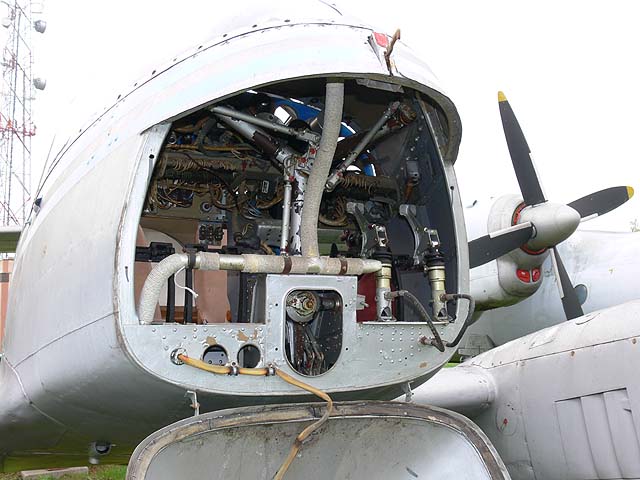 |
Első eset hogy repülőgép-műszerfal mögé látok. Legelöl a fűtő-párátlanító levegő fúvócsöve.
This is the first time I've
seen behind an airplane's instrument panel. The pipe at the
front is for the heater/defogger. |
 |
Nagyon elmés a kormányok rudazata, ha látnánk a folytatásukat, bizonyára újabb csemegékre bukkanhatnánk!
The network of rods belonging to the steering system is quite interesting. If we'd be able to follow it the rest of the way, we'd very likely find yet more interesting things! |
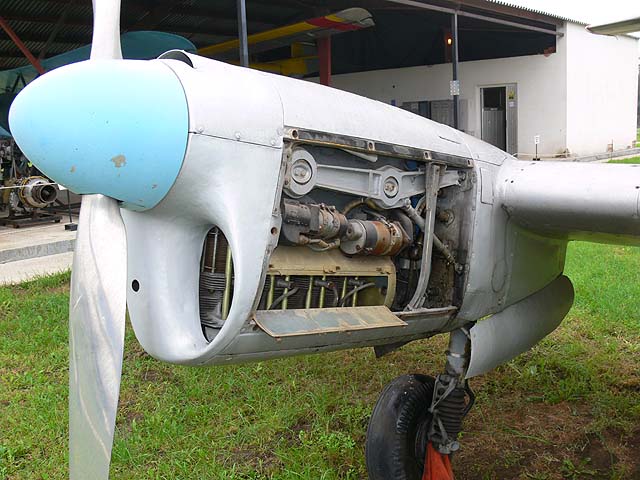 |
A jobb motor bal oldali takarólemez nélkül.
The right engine without its
left coverplate. |
 |
Felül a motortartó, alul a hengerek. A hútőlevegő terelő ajtaja nyitva, így lehet a gyújtógyertyákhoz férni. Középen két "villamos forgógép". A jobb oldali lehet a generátor (+ indítómotor?). Ha a bal oldali nem indítómotor, akkor a légcsavar-szög állítója.
On top is the mounting
bracket, on the bottom are the cylinders. With the cooling
system's door open, we can reach the sparkplugs. In the
middle, two electric motors. |